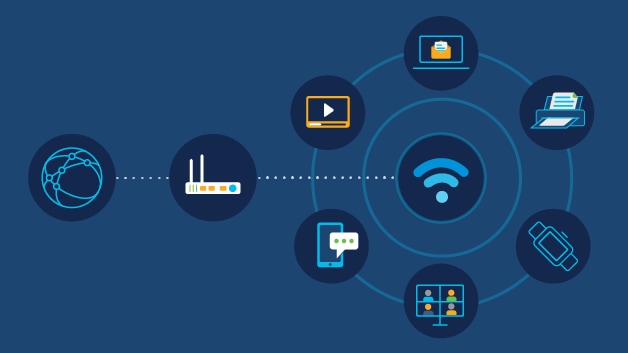What does Wi-Fi mean?
Wi-Fi is not an acronym; it is a brand name created by a marketing firm that’s meant to serve as an interoperability seal for marketing efforts.
How does Wi-Fi work?
On the technical side, the IEEE 802.11 standard defines the protocols that enable communications with current Wi-Fi-enabled wireless devices, including wireless routers and wireless access points. Wireless access points support different IEEE standards.
Each standard is an amendment that was ratified over time. The standards operate on varying frequencies, deliver different bandwidth, and support different numbers of channels. The latest standard is Wi-Fi 7.
What is a wireless access point?
A wireless access point (AP) allows wireless devices to connect to the wireless network. Having a Cisco wireless network makes it easy to bring new devices online and provides flexible support to mobile workers.
What a wireless access point does for your network is similar to what an amplifier does for your home stereo. An access point takes the bandwidth coming from a router and stretches it so that many devices can go on the network from farther distances away. But a wireless access point does more than simply extend Wi-Fi. It can also give useful data about the devices on the network, provide proactive security, and serve many other practical purposes.
What is a wireless router?
Wireless routers are commonly found in homes. They're the hardware devices that Internet service providers use to connect you to their cable or xDSL Internet network.
A wireless router is sometimes referred to as a wireless local area network (WLAN) device. A wireless network is also called a Wi-Fi network.
A wireless router combines the networking functions of a wireless access point and a router. Read more about wireless routers.
What is a desktop Wi-Fi router?
The most common way for users to connect to the Internet wirelessly is with a desktop wireless (Wi-Fi) router. These routers look like small boxes with multiple short antennas to help broadcast the signal throughout a home or workplace. The farther a user is from the base Wi-Fi router, the weaker the signal. So multiple wireless routers, called range extenders, usually are placed throughout the workspace. Wi-Fi range extenders, placed in an array, boost or extend Internet coverage.
What is a mobile hotspot?
A mobile hotspot is a common feature on smartphones with both tethered and untethered connections. When you turn on your phone’s mobile hotspot, you share your wireless network connection with other devices that can then access the Internet.
What is portable Wi-Fi hotspot?
A portable Wi-Fi hotspot is a mobile hotspot obtained through a cell phone carrier. It's a small device that uses cellular towers that broadcast high-speed 5G broadband signals. Multiple devices, like iPads and laptops, can then connect wirelessly to the device, which in turn seamlessly connects to the Internet where ever you travel. Similar to a cell phone, the portable hotspot's monthly cost is based on the data usage plan you select. A portable Wi-Fi hotspot is a more reliable way to access the Internet than searching for static public Wi-Fi hotspots.
Types of Wi-Fi deployments
There are three different types of deployments that an organization can choose from to create a wireless network. Each deployment has its own attributes that will work better for different solutions.
Centralized deployment
The most common type of wireless network system, traditionally deployed in campuses where buildings and networks are in close proximity. This deployment consolidates the wireless network, allowing for easier upgrades and enabling advanced wireless functionality. Controllers are based on-premises and are installed in a centralized location.
Converged deployment
A solution tailored for small campuses or branch offices. It provides customers with consistency in their wireless and wired connections. This deployment converges wired and wireless on one network device--an access switch--and performs the dual role of both switch and wireless controller.
Cloud-based deployment
Cloud-based deployment: A system that uses the cloud to manage network devices deployed on-premises at different locations. The solution requires Cisco Meraki cloud-managed devices, which have full visibility of the network through their dashboards.
